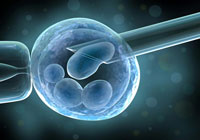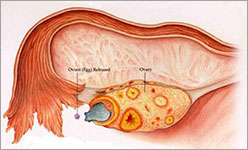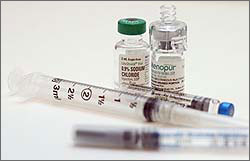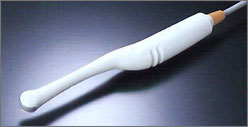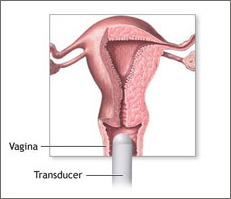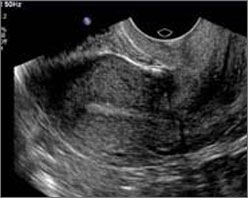-
 IVF TREATMENT
IVF TREATMENT
-

STEP TWO - EGG RETRIEVAL OR EGG PICK - UP Egg (oocyte) Retrieval involves aspiration of the ovarian follicles under anesthesia in the operating theatre adjacent to the I.V.F. Laboratory at the IVFPune unit This is done by the transvaginal ultrasound technique. The anaesthetic for the ultrasound procedure is very light. For this procedure a probe is inserted into the vagina and this projects a picture onto a monitor which enables the doctor to direct a needle into each follicle to retrieve the eggs. The fluid filled follicles are aspirated under slight suction into a test tube which is passed on the the embryologist. The scientist or embryologist locates the eggs, places them into culture media and then into the incubator.
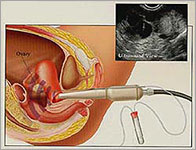
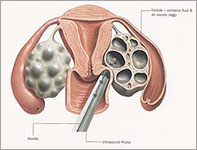
Ultrasound Guided Oocyte Retrieval Preparation for the egg pick - up - Information regarding what is involved for you All the instructions prior to the oocyte retrieval or egg pick-up will be given on the day the woman receives her hCG injection. The hCG injection is usually given late evening or in the night so as to schedule the pick-up in the morning around 34-36 hours later. On the day after the woman receives the hCG injection no stimulation drugs are to be taken. This is the day before the egg pick-up. Do not do any strenuous activity and abstain from sex. In fact the doctor will advise you regarding abstinence before the hCG is given. On the night before the egg pick-up the woman can have her dinner, but should not eat or drink anything after 10pm. She will have to come to IVF Pune the next day morning on an empty stomach, that is fasting. The time of reporting will be told to you along with all the other instructions. The husband will also have to come along with the wife as he will have to give the semen sample. Unless it is an ICSI procedure which also involves surgical retrieval of sperms the husband need not be fasting.
A written informed consent will have to be signed by the couple. As mentioned above the procedure is done in the IVF theatre under light anaesthesia.
After the procedure the woman will have to rest in the hospital for a few hours and will then be allowed to go home after ascertaining that all is fine. You will also be allowed to drink something after the effect of anesthesia wears out and can have a light meal at night. You will be started on progesterone supplementation from the day of the pick-up. see luteal phase support). You will also be told when to contact the unit and when to come back for the embryo transfer procedure.
As obvious this is a day procedure and there is no requirement for admission under normal circumstances.
-

STEP THREE - COLLECTION AND PREPARATION OF SEMEN SAMPLE. INSEMINATION, FERTILIZATION OF EGGS AND EMBRYO CULTURE  Semen Sample
Semen SamplePatients will be advised when the husband is required to produce a semen sample at the laboratory.
Samples are assessed initially before processing, with the count, motility, quality of motility and proportion of morphologically normal sperm being recorded.

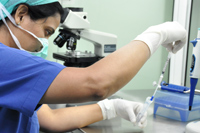
Sperm Preparation
The sample is then processed by centrifuging or spinning the specimen in a test tube through a sterile solution which acts as a sieve to catch dead and abnormal sperm. Forward swimming sperm are able to pass through the interface and are collected from the bottom of the tube. These sperm are washed and used for IVF. Most patients are requested to have a "trial run" sperm preparation prior to their cycle to determine sperm quality and thus the best form of treatment. InseminationOocytes are inseminated approximately 4 hours after egg pick-up using the microdrop technique. This involves suspending 100,000 sperm and one egg each in a tiny drop of culture media under sterile paraffin oil.
InseminationOocytes are inseminated approximately 4 hours after egg pick-up using the microdrop technique. This involves suspending 100,000 sperm and one egg each in a tiny drop of culture media under sterile paraffin oil.
This procedure confines the egg and sperm to a small volume, allowing more egg-sperm interaction. Thus the sperm and egg are fertilized outside the body, in the laboratory and cultured for 2-3 days.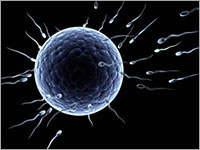
Insemination Fertilization
FertilizationThe eggs are checked for fertilization 18-20 hours after insemination has been performed. Those eggs which either have not fertilized or which are abnormally fertilized (polyspermy) are discarded. Normally fertilized eggs (called pronuclear-stage embryos) are cultured for a further 24-48 hours for subsequent embryo transfer.

Embryo Development
Embryos are assessed by looking at the stage of development (number of cells), the equality among the divided cells and the amount of fragmentation within the embryo.
The embryos are graded. 2-3 embryos of a good grade are then used for transfer into the uterine cavity. Excess embryos can be frozen.
-

STEP FOUR - EMBRYO TRANSFER During embryo transfer, the woman's legs are rested on stirrups, a speculum is inserted in the vagina and the embryos are transferred into the uterine cavity by a very fine catheter which is passed through the cervical canal. Usually no anaesthetic is required. This is usually done approximately 2-3 days after Egg Pick-up and the procedure takes 5-10 minutes. We usually recommend bed rest for 2-6 hours, however, you will be allowed to get up to go to the toilet and have refreshments during this time. You should have 48 hours rest at home after the embryo transfer and then you may return to your everyday activities. However, it is suggested that any strenuous exercise be avoided, and that sexual intercourse not be resumed until 1 week after embryo transfer. For those wishing to return to work, you may do so 2 days after the embryo transfer.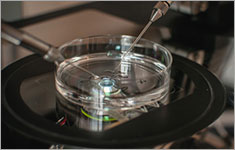
Loading EmbryosNotes for husbands on Semen Collection during the programme It is important to remember that sperm is constantly being produced and it takes 3 months to mature before it is ejaculated. You should keep this in mind 3 months prior to starting the programme. Smoking, alcohol, restrictive clothing and overheating such as saunas may all lower your sperm count. A general state of good health should be maintained. You may have intercourse during the treatment cycle, but please abstain from ejaculation for 2 days before your wife enters the hospital for her egg collection. Tests have shown that this period of abstinence produces the best possible sample. You should empty your bladder and wash your hands prior to producing the sample into the sterile jar provided. The sample should be produced at the IVF Pune unit for those undergoing the IVF procedure. In case you find it difficult to produce a sample at the unit, only then you may collect it at home and bring it to the laboratory provided it reaches the laboratory within half an hour of collection, earlier if possible. Procedure Side EffectsYou may have a vaginal discharge after an ultrasound pick-up and if this persists or becomes offensive, please contact the IVF Pune unit. Sometimes complications can arise from these procedures, relating either to the actual surgical procedure or to the anaesthetic and these can be further discussed with your consultant. The use of ovarian stimulation drugs and since more than one embryo is transferred the chances of multiple pregnancy are present. All this will be discussed with the couple during the counseling session.
Procedure Side EffectsYou may have a vaginal discharge after an ultrasound pick-up and if this persists or becomes offensive, please contact the IVF Pune unit. Sometimes complications can arise from these procedures, relating either to the actual surgical procedure or to the anaesthetic and these can be further discussed with your consultant. The use of ovarian stimulation drugs and since more than one embryo is transferred the chances of multiple pregnancy are present. All this will be discussed with the couple during the counseling session.
-

STEP FIVE - LUTEAL PHASE SUPPORT This is the treatment after the embryo transfer. However the progesterone supplementation is started in a low dose on the day of the egg pick-up.
As during the IVF treatment the ovaries are manipulated there is a possibility of inadequate hormonal support to help implantation and to the established pregnancy.
This may decrease the chance of a successful pregnancy or lead to an abortion of an established pregnancy if additional support with hormones is not given to the woman.
In order to avoid this you are given hormone drug supplements in the form of injections or vaginal suppositories which will provide adequate support to nurture the pregnancy. These should be taken daily as advised and not stopped without consulting your doctor.
Pregnancy Test and Pregnancy Ultrasound Scan We require you to do a pregnancy test 14 days after the embryo transfer procedure using the kit the unit has provided or the test can be done at the unit itself. The date when this test has to be done will be intimated before you leave the hospital after the embryo transfer procedure.
If the pregnancy test is positive, you will need to have an ultrasound scan at an appropriate time after the test so again, please contact us to organize this.
You may make an appointment to see your consultant at any time to discuss any queries you may have or to discuss future plans. Indeed we recommend that you do so if your treatment cycle is unsuccessful and a follow-up appointment will be arranged.
It is possible to start another IVF cycle after two further periods have elapsed or a frozen embryo cycle after one period.It is important that you contact the IVF Pune unit to notify us of the outcome of your treatment cycle. -

OTHER RELATED PROCEDURES The treatment cycle for the couple will remain as mentioned above. However certain micromanipulation techniques will be done or the embryo will be cultured longer in the following procedures. 
I.C.S.I. ( INTRA CYTOPLASMIC SPERM INJECTION ) This is a technique developed in Belgium in the early 90's whereby one sperm is injected into the cytoplasm of an egg. The ability of ICSI to achieve higher fertilization and pregnancy rates regardless of sperm caharcteristics makes it a very important micromanipulation technique.
Some of the indications when ICSI is done are

Very low sperm counts and motility 
Surgical sperm retrieval in cases of azoospermia 
Previous fertilization failure in IVF cycles 
Retrieval of very low number of eggs 
Cases where Preimplantation genetic diagnosis is to be done The technique of ICSI is very fine where the egg has to be held with a holding pipette and one single sperm is selected and injected inside with an injecting pipette. However, it should be considered that sub fertile men have a higher frequency of chromosomal abnormalities and the slightly increased risk of congenital abnormalities could also be related to the underlying cause on the male infertility.
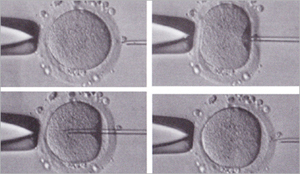
ICSIICSI pregnancy rates also depend on the quality of oocytes available from the woman and increasing maternal age and impaired oocyte quality can decrease ICSI-related pregnancy rates. Sometimes the scientists have to use the ICSI technique on patients who were previously considered appropriate for ordinary micro drop insemination. This can be due to factors such as poor quality semen or oocytes on the day of oocyte retrieval. Therefore all patients undergoing A.R.T. treatment are requested to sign a consent form for ICSI if they are agreeable to the procedure, even though the technique might not be performed. Blastocyst CultureApproximately five days after fertilization, the human embryo reaches a development stage termed the BLASTOCYST stage. The embryos have to be cultured in the laboratory for a longer period of 5 days for the embryos to reach this stage. This allows the good quality embryos to reach the is stage and helps in embryo selection. Presently studies do not support the routine use of Blastocyst transfer in all patients.
Blastocyst CultureApproximately five days after fertilization, the human embryo reaches a development stage termed the BLASTOCYST stage. The embryos have to be cultured in the laboratory for a longer period of 5 days for the embryos to reach this stage. This allows the good quality embryos to reach the is stage and helps in embryo selection. Presently studies do not support the routine use of Blastocyst transfer in all patients.
Patients should be aware that when the embryos are cultured for an extended period of time,the embryos may not survive this and may get arrested and there is a possibility that some patients by Day 5 will have no embryos for transfer.
The IVF Pune unit currently transfers embryos into the uterus after 2 - 3 days of cultre.
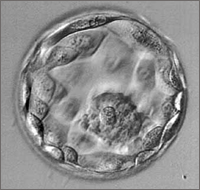
 Assisted Hatching of EmbryosThe outer shell of the embryo (called the Zona Pellucida) can sometimes become hardened and thickened, resulting in the embryo having difficulty in being released to attach to the uterus.
Assisted Hatching of EmbryosThe outer shell of the embryo (called the Zona Pellucida) can sometimes become hardened and thickened, resulting in the embryo having difficulty in being released to attach to the uterus.
It is possible to make an opening in the zona pellucida to help the embryo escape from its shell. This is called Assisted hatching. It is done in one of the following ways, by either cutting a slit in the zona using a fine glass needle or by drilling a hole in the zona using acidic culture medium or by using laser assisted hatching technique.
It is hoped that this technique will improve the chance of embryos implanting, thus resulting in pregnancy. Women who are older than 37, with repeated adverse TVF outcomes, and/or have a thickened zona pellucida, may be assisted with this procedure.
However, the technique may well result in a slightly increased chance of a multiple pregnancy because the embryo could split into two as it passes through the opening made in the zona. The implantation of more than one embryo increases the risk of problems occurring during the pregnancy.
Presently Assisted hatching is indicated only in certain cases as mentioned above and whether it improves the live birth rate is under debate.


 |
| Get in Touch : Deenanath Mangeshkar Hospital & Research Center Erandawane, Pune 411 004. | ||
| Email : ivf@dmhospital.org | Phone : 020 - 49153347 / 020 - 49153396 | |

